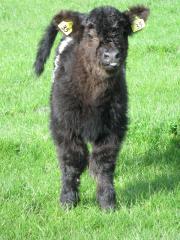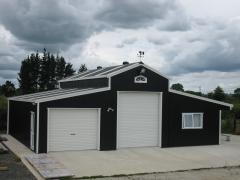
I bought my first belted cross heifer in 2002. A trip to the UK and to the English Royal Show, strengthened my interest in Belted Galloways, especially on hearing they were now rare in the UK due to the foot and 'mouth outbreak. I found and bought five registered pedigrees, in 2005. I have slowly been able to add to my herd, from outside purchases. In 2011 I sold my 150 acre dairy grazing farm in Waerenga and bought 50 acres of un-developed maize growing land in Pirongia, just below the mountain. Over the years since purchase, I have fenced, re-grassed, planted many trees, and have slowly built up the property, to be totally dedicated to my Belted Galloways.
With most of my life being on a dairy farm, and taking up calf club judging for 13 years, plus breeding and showing Appaloosa horses in the past, I feel I have a good eye for quality cattle. I have heavily reduced my herd down to some very good cattle. I was on the NZ Galloway Council for several years, with major improvements to the system put in progress. In 2011 my cattle took out 12 awards at the New Zealand Galloway Cattle Society Virtual Show, as well as Supreme Male and Supreme female Awards.

In 2011 I was approached by Genetic Enterprises New Zealand, who catalogue World-Wide sires, for suitable cattle for export semen and embryos. Several of my cattle were chosen for their use. I run at least three Stud bulls, with their own herds. This means I don't have to move them on. Their off-spring then go to an unrelated bull.
Breed History
Galloways are one of the oldest known British “Rare Breeds” of cattle naturally evolving, with first known written record of them some 500 years ago. They evolved in the region of South West Scotland in the area of the County of Galloway.
The defined region has a coastal strip, backed by undulating moors, granite hills, rough mountains and not much lush pasture. It is an area of wind and damp cold and experiences snow on higher ground. It is that rough weather and terrain that shaped the “Galloway” breed and produced the Galloway's unique double hair coat and the ability to utilise poorer “pasture” while producing excellent marbled meat. The Galloway is “Polled” (Hornless).
The “Belted Galloway” is thought to have been created some 300 years ago by crossing a “Dutch Belted Lakenvelder” with a Galloway to produce a hardy, strong animal with a great milking ability, genetically carrying the dominance of the Belting pattern.
The British Galloway Cattle Society was formed in March 1877. The first Registered Herd Book for “Belted Galloways” was started in Britain in 1921. The first “Belted Galloways” were imported into New Zealand in 1947.
Galloway Types include, “White Galloway”, “Belted Galloway” (Dun and Black belted) "Riggit Galloway”and Galloway.
Herd Health
Tuberculosis
The Herd has been tested yearly without any reactors, and is now C10. The herd is now on a 6 yearly test and they are NOT in a movement control area. The nearby Pirongia Mountain is under possum control.
Multi-6n1
The Calves are all double vaccinated with 6n1 vaccine.
Eczema
The herd is treated with Zinc to prevent Eczema in the dangerous summer months using an in-line water dispenser. Nutrimol is also added in-line to prevent grass staggers.
BVD
The whole herd has been tested negative for BVD. All calves born are tested for BVD. The farm is protected from any outside contact with double fenced tree lines, where necessary along neighbouring boundarys. All rivers and streams are fenced. Any incoming cattle all have to be tested BVD clear, before entry to the property.
Worms, ticks and lice
All cattle are treated with Bomectin pour-on and Blaze, when required.
